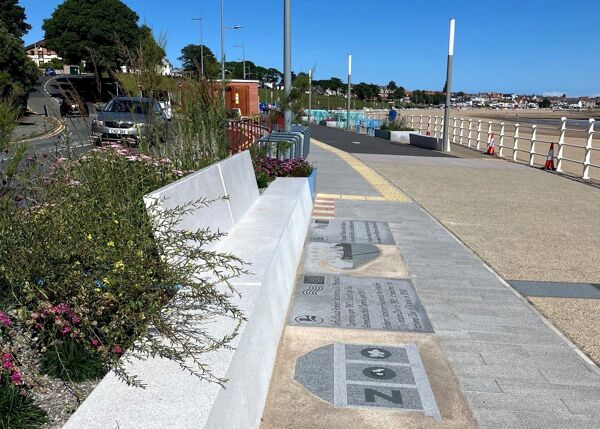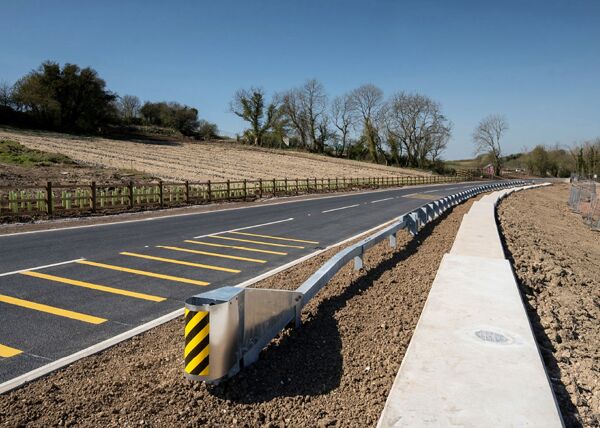
Northern Regional College has used NEC contracts to demolish and rebuild one of its six further-education campuses in Northern Ireland. Due for completion on time and budget in spring 2024, the new Coleraine campus in County Londonderry will be open for students at the start of the 2024/25 academic year in September 2024. The project has been funded by the college’s sponsoring department, the Northern Ireland Department for the Economy.
The work was awarded to contractor Heron Bros in November 2020 under a mix of NEC4 Engineering and Construction Contract (ECC) Option A (priced contract with activity schedule) and Option C (target contract with activity schedule). McAdam Design was the NEC project manager.
The first phase, procured under ECC Option A, was for demolition of most of the existing campus buildings on the triangular town-centre site, including a seven-storey reinforced concrete tower block at the corner of Union Street and Brook Street. The grade-B2-listed former St Patrick’s Church of Ireland Hall, which dates back to 1880 and was first used as a school, has been retained and refurbished as a self-contained performing arts and music centre.
The second phase, procured under ECC Option C, was construction of a new four-storey, steel-frame campus building. This provides 12,500 m2 of state-of-the art teaching and learning accommodation serving both the Coleraine area and nearby Ballymoney, where the college’s existing campus will be closed. The Breeam ‘excellent’ structure includes an innovation zone for project-based learning, conferences and performances, plus a student-managed restaurant and hair and beauty salon open to the public.
The new main entrance opens directly onto the adjacent Anderson Park, which has been integrated with the campus site via extensive landscaping works. The new entrance forms an important axis to the town centre, bringing additional benefits to traders and acting as a catalyst for regeneration works.
Contract innovation
 Northern Regional College project director Kieran Mooney says the college and McAdam undertook an extensive review of the procurement strategy to deliver Coleraine project. ‘At the time NEC3 was widely used for public-sector projects within Northern Ireland but NEC4 was still in its infancy. Following the review, we agreed that NEC4 ECC provided the best foundations for innovation.’
Northern Regional College project director Kieran Mooney says the college and McAdam undertook an extensive review of the procurement strategy to deliver Coleraine project. ‘At the time NEC3 was widely used for public-sector projects within Northern Ireland but NEC4 was still in its infancy. Following the review, we agreed that NEC4 ECC provided the best foundations for innovation.’
He says the project consisted of distinct pre-construction and construction phases. ‘To achieve close collaboration with all stakeholders and value for money within project timescales without sacrificing quality, it was agreed to use both ECC Options A and C.
Mooney says ECC Option A was used for the pre-construction phase to promote programme innovation. ‘This was to ensure the contractor delivered the design and site-clearance activities within the programme timescales. We then used ECC Option C for the construction phase to promote innovation through a shared-risk approach to costs. As the work progressed, we increased the pain/gain share to further encourage the contractor to use novel methods, reduce costs and accelerate the programme.’
He says the college worked with McAdam, college legal advisor Cleaver Fulton Rankin, government agency Construction and Procurement Delivery and the wider design team to draft the contract. ‘In addition to some bespoke terms, we adopted contractual mechanisms to provide not only traditional benefits such as cost surety, quality standards, risk mitigation and programme certainty but also to allow for contract innovation.’
Mooney says full use was made of ECC clause 16 on contractor’s proposals by encouraging new value-engineering provisions to promote shared savings between the parties. ‘We also used option X10 on information modelling to reflect our digital aspirations for the project and avoid design errors, and option X21 on whole-life cost to help reduce our long-term maintenance costs.’
Comprehensive scope
McAdam technical director of project management Chris Hughes says a key part of the contract drafting was to include the innovation requirements in the scope. ‘These included measures such as using a virtual learning environment, augmented reality for presenting designs to college staff and students, and an asset information model linked to the college’s computer-aided facility management system to achieve operational costs reductions of 30%.’
He says the scope also specified use of a common data environment to provide defect management, document control, and health and safety monitoring. ‘The common data environment provided a platform for maximum efficiency between all parties and was 70% more efficient that traditional methods.’
Hughes says key performance indicators were included in the scope too. ‘These further increased innovation by monitoring the performance of both parties with scheduled reviews undertaken throughout the contract. Infographics were used assess the performance of both design and waste management, resulting in Heron Bros achieving 99% of the 4901 t of demolition waste being recycled.’
He adds that engagement requirements in the scope encouraged the contractor to take opportunities to promote innovation through apprenticeships, project-based learning for students, an entrepreneurship club and practical opportunities. ‘A total of 11 students worked on the project, gaining invaluable experience and the possibility of securing future job opportunities.’
Overall Hughes says the contracts worked very well. ‘The NEC requirement to act in a “spirit of mutual trust and co-operation” ensured maximum collaboration between the parties. The early warning mechanism meant that all risks were promptly identified and mitigated, and the contract drafting and options encouraged in an innovative approach by the contractor. The building will be completed on time and budget, well before the start of the next academic year in September 2024.’
Benefits of using NEC
- NEC’s wide choice of main options allowed a priced contract to be used for the pre-construction phase to encourage programme innovation, and a target contract for the construction phase to promote innovations leading to cost savings.
- NEC drafting flexibility enabled innovation requirements, key performance indicators and engagement requirements to be included in the scope, ensuring the client’s desire outcomes were achieved.
- NEC requirement to act in a ‘spirit of mutual trust and co-operation’ ensured maximum collaboration between the parties, while NEC early warning mechanism meant that all risks were promptly identified and mitigated.




